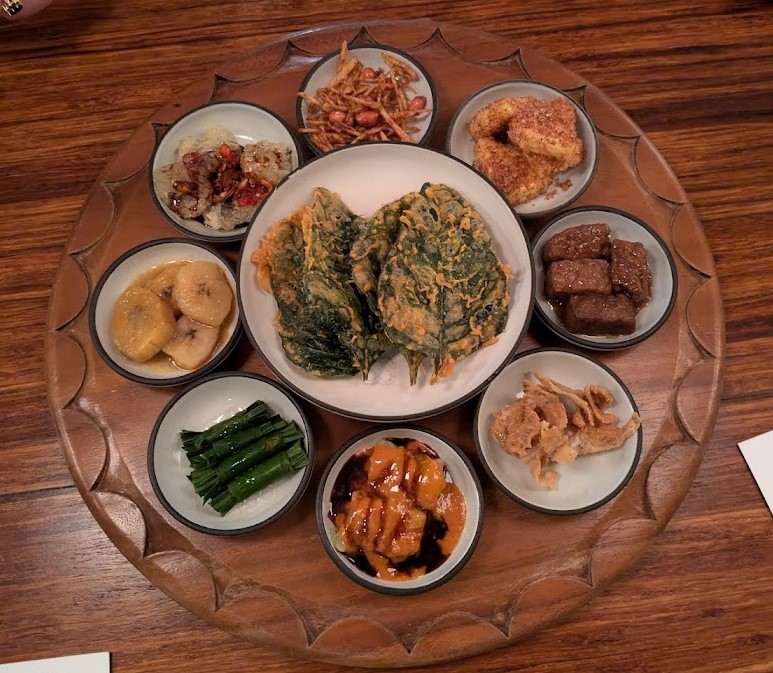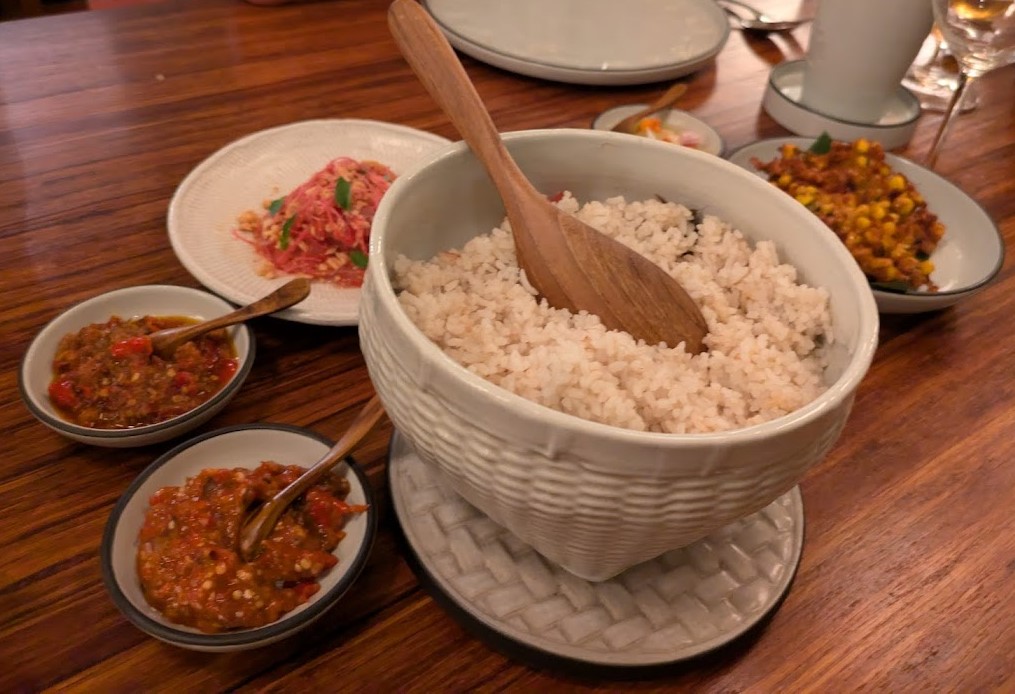This theory for interior design also applies to the use of chilli in Bali. And if there isn’t enough chilli in the dish already, there is always sambal. This Indonesian red hot chilli relish will ensure that food in Bali is never boring.
(This table decoration was not originally intended as a spice rack, but is one of the oldest known games in the world. Congklak can be traced back to Ancient Egypt, and was probably brought to Indonesia by Arab or Indian traders. It is a challenging, strategic game, played with about a hundred small cowrie shells or beads, divided evenly between the indentations.)
The heat of the day had accumulated on my skin in much the same way that chilli does. You know, that frog in the pot scenario, when the water heats up gradually until – suddenly – it is overwhelming and you are being boiled alive. A day in Bali’s dense and humid heat has left me feeling like I’ve hit a brick wall. So, the fact that our friends have chosen a modern, airconditioned restaurant for dinner makes me immensely grateful. For half an hour I relish the fact that my body heat is slowly dispersing in this cool haven.
Then the food begins to arrive and the heat from my skin quickly becomes centred in my belly, as almost every dish has fresh chilli, chilli paste, chilli sauce… chilli, chilli, chilli!
At some point – too late – I remember that wine never reduces the effect of chilli but rather exacerbates it. Water is not enough, either – I have guzzled two large bottles to little effect. Finally, I resort to stealing gulps of beer from the One & Only’s glass. Beer has never been my drink of choice, but as it turns out, it is incredibly effective at quenching the heat in my mouth. And unexpectedly, in this moment, it my favourite drink in the world!
Which is not to suggest that there is anything wrong with the food. The food is fabulous. Just hot.
Nusantara, it transpires, is the name of the new capital of Indonesia, based in East Kalimantan on the island of Borneo. It is also the name of a great dining experience in the heart of Ubud. Nusantara is an Old Javanese word derived from nūsa – ‘island’ – and antara – ‘between’. It means “outer island” which seems to make more sense in relation to Bali than to Indonesia’s new capital. However, in modern Indonesia, nusantara reflects the country’s status as an archipelagic state of islands between the Indian Ocean and the Pacific. Enough with the geography lesson, back to the subject at hand. Food.
Nusantara is a high end Indonesian restaurant, a sibling of the popular Restaurant Locavore. Focussing on Indonesia’s culinary heritage, the band of talented chefs at Nusantara introduces visitors to wonderful flavours from all over this equatorial archipelago.
Having been warmly welcomed into the delightfully cool and airy Nusantara Restaurant, we are asked to choose between the set menu or à la carte. We all feel that à la carte means too many choices and decisions are too hard to make when my brain has melted into a claggy mess, so we cheerfully opt for the set menu. Let the show begin!
Our lovely waiter emerges with a tasting platter consisting of nine small dishes – Berbagi Rasi – complete with a descriptive chart to ascertain what we are eating.

Wafer thin potato fries and peanuts marinated in chilli and kaffir lime leaves; tiny, salted fish like crispy whitebait, and ‘young’ bananas braised in gulai spice paste, all served in small, round dishes. (Gulai spice is a complex paste that consists of turmeric, coriander, black pepper, galangal, shallot, garlic, fennel, and lemongrass. And chilli pepper, of course. There are pineapple pieces dipped in dried chillis, shrimp paste and palm sugar (my favourite blend of heat and sweet) and a rather surprising deep fried tapioca served with sambal and leek. Surprising, in that tapioca does not usually curry favour with my taste buds, but this morsel is delicious. In the centre of the platter, large, crispy amaranth leaves have been marinated in turmeric, chilli and coriander seeds and deep fried – a most sophisticated and tasty papadum. And are you seeing a theme? Barely a single dish escapes a chilli invasion in some form, be it dried, fresh or paste, sambal or sauce. And the theme continues through the main courses.
After indulging in a bowl of delicately flavoured soup broth filled with slices of fresh coconut meat, I dip into a hearty meat dish: goat leg braised in coconut milk, a divine array of spices and a sprinkle of candlenuts to thicken the sauce. And, of course, the ubiquitous chilli.
Moringa leaves I remember from the Philippines as malunggay. Native to the Indian subcontinent, this plant is used extensively in South and Southeast Asia and is packed with potassium and anti-oxidants. Tonight, it has been cooked in a young coconut over an open wood fire with a base genep – a traditional blend of 15 local spices, including chilli, that gives Balinese cooking its distinct flavour.
Then there is an array of seafood. Pacco Tuna from South Sulawesi is the Balinese version of sashimi, although this adaptation is marinated in a chilli and garlic paste, which adds spice, but does rather blot out the delicate flavour of the raw tuna. Nonetheless we all dip in for more.
From Western Sumatra, a prawn dish known as Udang Bakar Padang. These King prawns have been marinated in a light, satay-style sauce, then grilled over an open wood fire. We can peel them from their shells with ease. Fabulous.
And Sambal Cakalang from Manado, North Sulawesi is, in English, shredded smoked mackerel, with chillis and shallots.
The other ubiquitous ingredient in our Balinese feast is rice. Steamed with pandan leaves, lemongrass, and salam leaves – an essential ingredient in Balinese cooking, apparently – this heritage rice from Central Bali is subtly flavoured, cooked al dente and served in a pretty pot.

Then we are introduced to Babi Masak Dibulu. This dish from North Sulawesi consists of pork shoulder marinated in turmeric, kaffir lime leaves, kemangi leaves (a lemon basil) and coconut milk, cooked in a bamboo tube on an open wood fire. This one is surprisingly mild – but the sambal sauce is at hand if you feel the urge to season it. For the vegetarians, there is a snappy corn fritter, which we are kindly invited to share. We finish up with a light coconut milk pancake flavoured with pandan.
And there it is. A meal that engages all the senses: flavour, texture, colour, aroma, the crunch of the teri goreng and a tendency to pick out a piece of pineapple or an amaranth leaf with my fingers so I can engage all my senses with a final flourish.


